Proper nouns refer to names of objects, specific nouns indicate people, animals, plants, utensils, and objects connected to a singular or plural sub-element. The following links have been built:
- DpN: Connect the plural determiner with the noun.
- DsN: Connect singular adjectives with nouns.
Similarly, this position is also for the number of quantity words (Mc). The link that exists only between the number of words and the specific noun is named McNt.
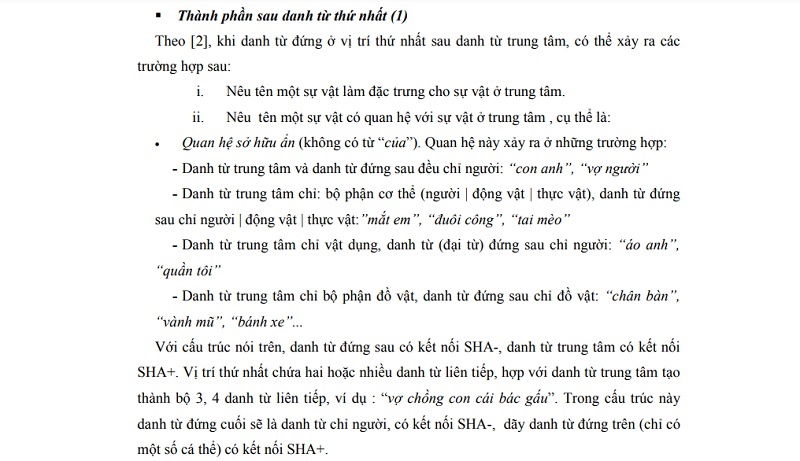
In this position, it is necessary to build specific links indicating which cases are accompanied by nouns indicating the type or number of words, and which cases are not.
For example, Vietnamese always says “dogs” but never “dogs”. However, it is possible to say “students” or “students”. Therefore, it is necessary to build links for each specific case.
The formula for person nouns:{DpNt- or McNt-} & {NcN1-} allows the following expressions to be accepted: “student”, “students”, “5 students”, “born” tablets”.
The formula for animal nouns is different. Nouns of this type cannot lack nouns of the type that accompany them when they are accompanied by a number of words or an adjective indicating quantity. The thesis has proposed a formula for nouns indicating animals and plants:
(NcN2- or NcN3-) & {DpNt- or McNt-}
The formula for nouns referring to things and objects is similar to that for nouns referring to people:
Maybe you are interested!
-
 Vietnamese linking grammar model - 7
Vietnamese linking grammar model - 7 -
 Vietnamese linking grammar model - 8
Vietnamese linking grammar model - 8 -
 Links Of Nouns Act As Subject And Complement
Links Of Nouns Act As Subject And Complement -
 Vietnamese linking grammar model - 11
Vietnamese linking grammar model - 11 -
 Link Building Based On Adjective Structure
Link Building Based On Adjective Structure -
 Vietnamese linking grammar model - 13
Vietnamese linking grammar model - 13
{NcN4-} & {DpNt- or McNt-}
Thus, the following phrases are recognized: “tables”, “each chair”. The links in the phrase “tables” are shown in Figure 2.2 .
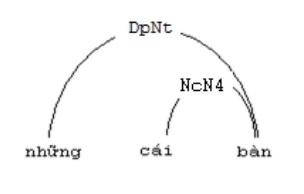
Figure 2.2. Links in the phrase “tables”
However, the phrases “tables”, “several chairs” are still used frequently in Vietnamese and the formulas also satisfy this. The following phrases will not be recognized: “three tables”, ” all four chairs”.
- Connection for the first sub-component (-3)
This position is related to several types of words: preposition of quantity (“all”, “all”, etc.), determiner of quantity (“all”, “most”, “most”, “most”. “…). In some cases, another word is also in this position, for example, “whole” is an abstract noun. The built-in connection is DqNt-. When there are more links with position -3, the linking formulas should be reviewed as follows:
In Vietnamese, people say “all students”, “all students”, even “all students”, “all 3000 students” but the sentence “all students” does not exist. the student”. So with nouns referring to people, we have the linking formula:
{NcNt1-} &(DpNt- &DqNt- or McNt-&DqNt-)
Likewise, animal nouns have the formula:
{NcNt2- or NcNt3-} (DpNt- & DqNt- or McNt- &DqNt-&)
Nouns for objects:
{NcNt3-}&(DpNt- &DqNt- or McNt-& DqNt-)
Nouns for substances, works, components, collective nouns, some abstract nouns: DqN
b. The auxiliary element after the noun
Subsequent elements also follow strict rules. The thesis in turn considers the sub-elements according to their position of appearance.
- Composition after the first noun (1)
According to [2], when the noun comes in first place after the central noun, the following cases can happen:
- Name an object that characterizes the thing in the center.
- Name an object that is related to the thing in the center, namely:
- Hidden ownership relationship (without the word “of”). This relationship occurs in the following cases:
– The central noun and the noun after all refer to people: “your son”, “his wife”
– Central nouns: body parts (people | animals | plants), nouns after people | animals | plants: “my eyes”, “peacock tails”, “cat ears”
– The central noun indicates the item, the noun (pronoun) after the person: “your shirt”, “my pants”
– The central noun indicates the part of the object, the noun after the object indicates: “table leg”, “hat rim”, “wheel”…
With the above structure, the noun after has a SHA- connection, the central noun has a SHA+ connection. The first position contains two or more consecutive nouns, which combine with the central noun to form a set of 3 or 4 consecutive nouns, for example: “bearer’s wife and children”. In this structure, the last noun will be a person noun with a SHA- connection, the top noun sequence (with only a few individuals) has a SHA+ connection.
- Relationship in terms of materials (without the word “equal”): “brick yard”, “wooden house”. This type of relationship occurs when the noun comes after the substance. The central noun in this relation has a CLI+ association.
- Content- and heading-oriented relationship, for example “military line”, “philosophical opinion” occurs when the noun following is an abstract noun indicating a specialized term: NN+. Nouns that follow have NN- connections.
- Comparative relation, for example, “oval face”. This relationship only occurs for some special cases: NS+.
- The relationship of location, location, …, for example “suburban villa” occurs when the central noun indicates the building, the noun after the location. The central noun has the NN+ relationship, the second noun has the NN- relationship.
Eg
table, bed, spring: NN- or ({NcNt4-} & {DpNt- or McNt-} & {PqNt}& {NN+}).
This rule allows to avoid ambiguity when the auxiliary components before and after the first noun are modified to the subordinate noun after (as in the example above, the word “that” is not connected with ” springs”).
Figure 2.3. shows links for the phrase “spring bed”.
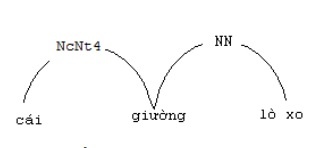
Figure 2.3. Link in the phrase “spring bed”.
The first position after the central noun can also be used for modifiers. Playing this role is usually a type of adjective indicating properties, sometimes also using onomatopoeia and onomatopoeia. The SA link is used in this case.
- Composition after the third noun (3)
This sub-component combines with the specific noun in the center through the material preposition “equal to”, “from” or the preposition of the range “about” in the form: N1 + equals / about + N2. In this case, we construct the following rule:
- Nouns with additional connections NtEm+ and NtEs+.
- Prepositions indicating material “equal”, “word” have a CH+ connection.
To connect these word relations with the subordinate nouns that follow, use the naming link CH- (Only associated with specific nouns of material).
equals, from: NtEm- &CH+
The range preposition “about” has NtEs connections. Connect with the following noun via EsNt+
about: NtEs- & EsNt+.
Nouns of material have a CH- connection.
Some other types of nouns have an additional EsNt- connection.
Figure 2.4 shows the links in the phrase “wooden table” with the material noun “wood” in the third position.
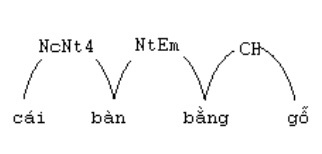
Figure 2.4. Links in the phrase “wooden table”
- The element after the present possessive noun (position 3 or 4)
This sub-component is combined with the center with the possessive preposition “of”, “at”: N1 + of/at + N2. Nouns and pronouns add SH- connections.
The word relationship “of”, “in” has a connection between SH+ and Neo
Nouns adding the relation NEo+
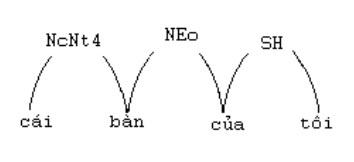
Figure 2.5. Links in the phrase “my desk”






